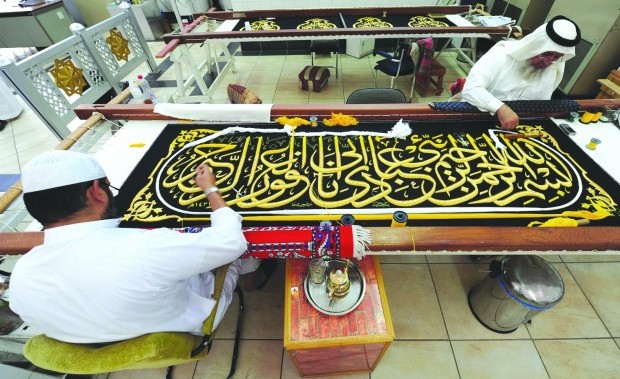
Saudi worker sew Islamic calligraphy in gold thread on a drape to cover the Kaaba at the Kiswa factory in the holy city of Mecca on November 8, 2010. (AFP/Mustafa Ozer)
Mecca, Asharq Al-Awsat—The Ka’aba, Islam’s holiest shrine, is the black cuboid located in Al-Masjid Al-Haram in the holy city of Mecca. Directing oneself towards the shrine—an act known as Qiblah—is an obligatory aspect of prayer for all Muslims. The shrine is also the destination for millions of pilgrims every year. Last year, the number of Muslim pilgrims totaled 3,161,573; an 8 percent increase from 2011, according to Saudi Arabian officials.
But while the shrine itself has remained the same for many centuries, the famous black cloth that covers it is changed every year. Draped over the Ka’aba is 658 square meters of black silk cloth embroidered with gold and silver. This famous cover is known as the Kiswah and it has been made in Saudi Arabia since 1927, according to Al-Joudy, a professor of modern Islamic history.
He told Asharq Al-Awsat that “the history of covering the Kiswah covers several historical periods. The most important of these is the era of the Prophet Muhammad—peace be upon him—who was weary of the polytheists’ hostility. They did not let him shroud the Ka’aba until Mecca was conquered.”
The same cloth remained there until it was accidentally burned in an attempt to fumigate the cloth using incense. Muhammad then began the tradition of annually renewing the Kiswah, which was continued by the caliphs who ruled in his stead.
With the advent of the Ummayyad Caliphate, a new Kiswah replaced the old one twice a year. The first took place in a ceremony on tenth day of Muharram, the first month of the Islamic calendar, and the second on the last day of the holy month of Ramadan, before the Eid Al-Fitr celebrations.
During the Abbasid period, three separate colors were used at different times, until Al-Nasir li-Din Allah, the 34th Abbasid caliph, decided to use only a black Kiswah. This tradition has continued to this day.
In 1927, King Abdulaziz issued a royal order for the construction of factories and villages dedicated to making the Kiswah. Sheikh Abdul Rahman Al-Ansari was the first manager of the factory, and in 1977 he established a new facility for manufacturing the Kiswah, where they are madeto this day.
Dr. Mohammed Bajouda, manger of the Kiswah factory, told Asharq Al-Awsat that “the Kiswah consists of 47 reels of cloth, each of which are 14 meters [46 feet] in length and 95 centimeters [3 feet] wide.”
While the materials used to be sourced from Egypt and the surrounding countries, the finest silk threads are now imported from Switzerland and Italy. Costing SAR 20 million (USD 5.3 million), the Kiswah is the most expensive cloth in the world. According to Bajouda, this sum of money includes the cost of raw materials, wages for those involved in the construction and administration costs.
The top third of the cover—46 feet (14 meters) high—is framed with verses from the Qu’ran and other Islamic decorations. Beneath this, there is a frame for the entrance to the Ka’aba, also made of pure silk. It is 23 feet (7 meters) high and 13 feet (4 meters) wide, and also contains Qu’ranic verses and other embroideries made from gold and silver thread.
